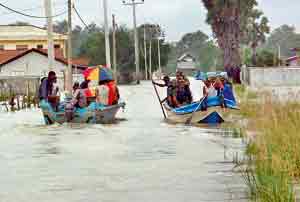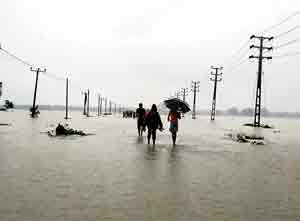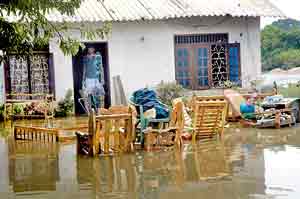POLONNARUWA: Four days after the flooding began, this ancient “dry zone” city is a sea of muddy brown water. On every side, the scene is muddy water, muddied roads and messy fields. Polonnaruwa, city of ancient ruins, will be remembered for the brown waters that covered everything in sight for days. In places, the dirty flood waters are slowly receding. The people look anxious and depressed. While the landscape is brown, the sky is grey, carrying the threat of more rain to come. The prevailing mood is one of gloom.
It is a scene of destroyed houses and shops, ruined properties, and tanks swollen with water. Four people have died and five are missing since floods hit the area.
Sungawila is one of the worst-hit areas. One victim, a senior citizen in the village of Sungawila, had a heart attack and died on seeing his house crumbling under the force of the flood waters.
 |
| Newly appointed Commander of the Army's Eastern area Major General Boniface Perera travels in a boat assessing damage caused by the floods in the Batticaloa district. All troops in the east have been placed under his charge for flood relief operations. |
 |
| Water dominates the grey landscape of Ampara. Pix Wasantha Chandrapala |
 |
| Occupants and belongings pushed out of homes. Pic by Saman Kariyawasam |
 |
| Exam notes and texts ruined by floods. |
S. Ibrahim, whose house has disappeared, said between 200 and 300 acres of cultivated paddy land around his home have been destroyed, and 6,000 head of cattle are trapped on high land 12 kilometres away.
An estimated 2,500 head of cattle, most of them calves, are believed to have been washed away in the floods.
Resident A. Chandralekha, who is among dozens of homeless people camping out at the Sorivila Tamil School, told the Sunday Times that when she went for a bath with her two-year-old child, she little realised that she would not have a home to go back to. “My house was smashed by the heavy rains and flood waters,” she said.
Up to last Wednesday, a total of 13,737 people, or 3,059 families, had been displaced by the floods in Polonnaruwa. At least 30 shelters have been set up. Paddy fields ripe for harvest are under two metres of wate, and look like tanks.
The Sri Lanka Navy rushed to the scene as soon as the flooding reached dangerous levels, and has been assisting in rescue and relief work. The Sunday Times team joined Navy personnel travelling in boats to survey flood-hit areas. In some areas, houses were either submerged or only the rooftops were visible.
The waters had reached as far as the Somavathi Temple area, which was surrounded by water. Resident monks, Army personnel and civilians had been marooned there for days.
Residents are in a state of shock, struggling to grasp the full extent of the destruction.
Displaced persons housed at the Al-Hilal Central School in Thambala said they were not warned that the floods could reach their homes.
However, the Grama Sewaka for the area, Mr. A. Herath, said the residents had been were warned, but they had not taken the warning seriously. He said the damage was considerable – destroyed houses, ruined rice fields, polluted wells, and drowned or missing livestock.
Meanwhile, the displaced and homeless are hoping the government will make good on its promise of speedy relief and help. “For now, we have sufficient funds only for food, and even this is not enough,” the Grama Sewaka said. “We are allowed to spend not more than Rs. 100 per adult and Rs. 50 per child a day. More assistance is desperately needed.”
Sluice gates of tanks in the Polonnaruwa area have been opened to let out excess water: 12 gates at the Kaudulla Tank; 10 at the Parakrama Samudra, and eight at the Minneriya Wewa, according to the Disaster Management Centre. Meanwhile, the Giritale Wewa is overflowing,
But the excess water has caused havoc in low-level areas, both in Polonnaruwa and in Batticaloa. Although the rains have ceased, the released water has caused more flooding.
As of last Thursday, when the Sunday Times team was in Polonnaruwa, all 64 tanks in the Dimbulagala and Welikanda Divisional Secretariats had reached spill level.
Many families have converted lorries into temporary homes.
The Polonnaruwa Government Agent, Nimal Abeysinghe, told the Sunday Times that appeals for aid have gone out. Among urgently needed items were school uniforms and material, socks and shoes for schoolchildren.
Compensation concerns
Houses affected by the overflowing Mahaweli include a cluster of permanent and temporary structures, just outside the Manampitiya Bridge and Devale Junction. It is understood that most of these buildings are illegal structures. Forty-five families live here. Nine of the families are original residents who were given their houses by the late President R. Premadasa. Electricity and other facilities were included.
The state land occupied by these 45 families is shared by the Sri Lanka Railways, the Forest Department and the Road Development Authority. S. Leelawathi, one of the original residents, said she and the others settled there 40 years ago.
VOLUMES OF DAMAGE
As rains resumed last Friday, and the Mahaweli Ganga started rising, villagers living near the famous Manampitiya Bridge have been forced to abandon their homes and seek temporary refuge in makeshift shelters. Others have come back after three days only to find their homes still under water.
On dry ground around the Manampitiya Devala Junction, schoolbooks were left out in the sun to dry. Many of the books looked unusable. GCE Ordinary Level student Nalinda Pushpakumara was gazing at his soaked books and notes. He told the Sunday Times that he was sitting for the exam this year. He looked very unhappy.
Dambulla drenched
By Kanchana Kumara Ariyadasa
It has been raining steadily in Dambulla since Christmas Eve, and dozens of families have left their houses to live in camps. They say they have received no assistance to date.The economic centres at Dambulla, Habaranawala and Pahalawewa remain under water. There has been an 80 per cent drop in the volume of the vegetables brought to the economic centres.
|






